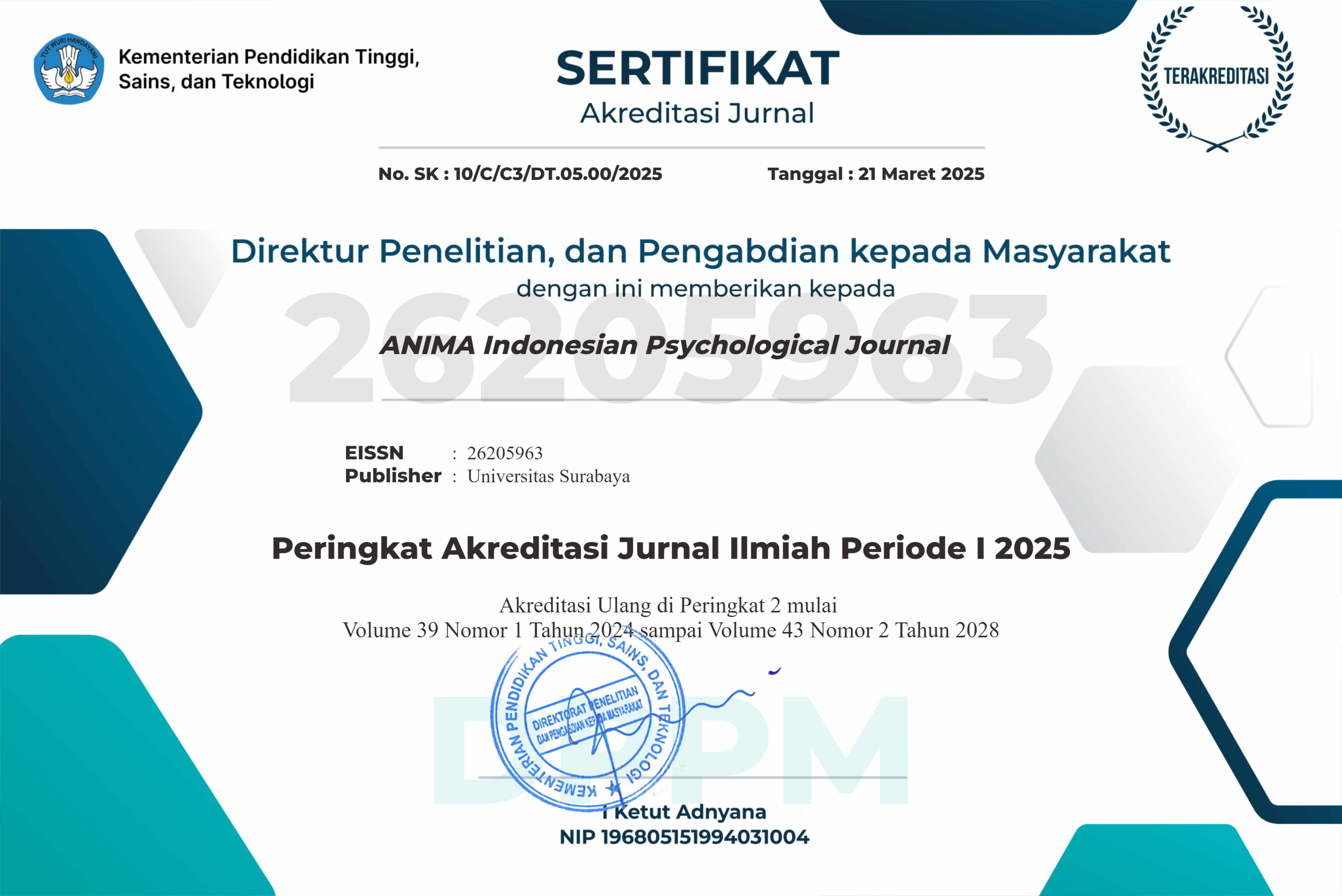The Subjective Well-Being of Indonesian Children: Exploring Emotional and Cognitive Dimensions
 Abstract Views:
588 times
Abstract Views:
588 times
 PDF - Full Text Downloads:
185 times
PDF - Full Text Downloads:
185 times
 Video Downloads:
27 times
Video Downloads:
27 times
Abstract
Savahl et al. (2021) propose a quadripartite model for children's subjective well-being (SWB) that includes both: global (context-free items assessing overall well-being) and specific (domain-based items evaluating particular life aspects) cognitive components, as well as positive affect (PA) and negative affect (NA). The goal of this study is to test this model of SWB among Indonesian children using data from the third wave of the Children’s Worlds Survey. A representative sample of West Java children aged 10 and 12 years (N = 9,526). Data analysis involved confirmatory factor analysis (CFA). Results for a model with a second-order latent variable using the pooled sample displayed good fit indexes. The second-order analysis showed significant standardized regression weights of the SWB items of each latent variable, and of the first order latent variables on the second order latent variable as expected The high internal consistency of the CW-SWBS5, CW-DBSWBS, and CW-PNAS indicates that the quadripartite model of SWB is psychometrically robust among Indonesian children aged 10 and 12. However, the notably low factor loadings for items related to “satisfaction with the people children live with”—particularly when compared to higher-loading items such as “satisfaction with safety”—suggest a potential cultural divergence in how certain SWB domains are interpreted. Multigroup CFA showed that all statistics can be meaningfully compared between boys and girls and between 10 and 12-year-olds age groups. The findings of this study confirm this model can be used with Indonesian children and results offer valuable insights for parents, teachers, and policymakers aiming to develop evidence-based interventions that support child well-being across cognitive and emotional domains.
Downloads
References
Abubakar, A., van de Vijver, F. J. R., Suryani, A. O, Handayani, P., & Pandia, S. P. (2015). Perception of parenting styles and their associations with mental health and life satisfaction among urban Indonesian adolescents. Journal of Child and Family Studies, 24, 2680-2692. https://doi.org/10.1007/s10826-014-0070-x
Arbuckle, J. L. (2010). IBM SPSS® Amos™ 19 user’s guide. Amos Development Corporation. http://amosdevelopment.com/download/amos.pdf
Badan Pusat Statistik Provinsi Jawa Barat. (2020). Jumlah penduduk menurut kabupaten/kota (jiwa) 2018-2020. https://jabar.bps.go.id/id/statistics-table/2/MTMzIzI=/jumlah-penduduk-menurut-kabupaten-kota.html
Ben-Arieh, A. (2008). The child indicator movement: Past, present, and future. Child Indicators Research, 1(1), 3-16. https://doi.org/10.1007/s12187-007-9003-1
Ben-Arieh, A., Casas, F., Frønes, I., & Korbin, J. E. (2014). Multifaceted concept of child well-being. In A. Ben-Arieh, F. Casas, I. Frønes, & J. E. Korbin (Eds.), Handbook of child well-being: Global perspectives (pp. 1-27). Springer. https://doi.org/10.1007/978-90-481-9063-8_134
Borgers, N., de Leeuw, E., & Hox, J. (2000). Children as respondents in survey research: Cognitive development and response quality 1. Bulletin of Sociological Methodology [Bulletin de Méthodologie Sociologique], 66(1), 60-75. https://doi.org/10.1177/075910630006600106
Borualogo, I. S., & Casas, F. (2019). Adaptation and validation of the Children’s Worlds Subjective Well-Being Scale (CW-SWBS) in Indonesia. Jurnal Psikologi: Indonesian Journal of Psychology (JPSI), 46(2), 102-116. https://doi.org/10.22146/jpsi.38995
Borualogo, I. S., & Casas, F. (2021a). Subjective well-being of bullied children in Indonesia. Applied Research in Quality of Life, 16, 753-773. https://doi.org/10.1007/s11482-019-09778-1
Borualogo, I. S., & Casas, F. (2021b). Subjective well-being of Indonesian children: A perspective of material well-being [Kesejahteraan subjektif anak Indonesia: Sebuah perspektif kesejahteraan materi]. ANIMA Indonesian Psychological Journal, 36(2), 204-230. https://doi.org/10.24123/aipj.v36i2.2880
Borualogo, I. S., & Casas, F. (2024). Children with homeostatically maintained and homeostatically defeated subjective well-being in Indonesia. Children and Youth Services Review, 162: 107701. https://doi.org/10.1016/j.childyouth.2024.107701
Brown, T. A. (2015). Confirmatory factor analysis for applied research (2nd ed.). The Guilford Press. https://psycnet.apa.org/record/2015-10560-000
Byrne, B. M. (2010). Structural equation modeling with AMOS. Basic concepts, applications, and programming (2nd ed.). Routledge. https://doi.org/10.4324/9781315757421
Casas, F. (2017). Analysing the comparability of 3 multi-item subjective well-being psychometric scales among 15 countries using samples of 10 and 12-year-olds. Child Indicators Research, 10, 297-330. https://doi.org/10.1007/s12187-015-9360-0
Casas, F., & González-Carrasco, M. (2019). Subjective well-being decreasing with age: New research on children over 8. Child Development, 90(2), 375-394. https://doi.org/10.1111/cdev.13133
Casas, F., & González-Carrasco, M. (2020). The evolution of positive and negative affect in a longitudinal sample of children and adolescents. Child Indicators Research, 13, 1503-1521. https://doi.org/10.1007/s12187-019-09703-w
Casas, F., & González-Carrasco, M. (2021). Analysing the comparability of four multi-item well-being psychometric scales among 35 countries using Children’s Worlds 3rd wave 10 and 12-year-olds samples. Child Indicators Research, 14, 1829-1861. https://doi.org/10.1007/s12187-021-09825-0
Casas, F., Savahl, S., González-Carrasco, M., & Adams, S. (2024). Child well-being: Children’s perceptions and experiences. In E. Fernandez, P. Welbourne, B. Lee, & J. L. C. Ma. (Eds.), The Routledge handbook of child and family social work research: Knowledge-building, application, and impact (pp.53-69). Routledge. https://www.routledge.com/The-Routledge-Handbook-of-Child-and-Family-Social-Work-Research-Knowledge-Building-Application-and-Impact/Fernandez-Welbourne-Lee-LCMa/p/book/9781032148649?srsltid=AfmBOoqVOsfiFG5PjIYTpBPFMbZT7CUv_nyEUWeo-J3Ht4aEJk7pjxVo
Chen, F. F. (2007). Sensitivity of goodness of fit indexes to lack of measurement invariance. Structural Equation Modeling, 14(3), 464-504. https://doi.org/10.1080/10705510701301834
Cheung, G. W., & Rensvold, R. B. (2001). The effect of model parsimony and sampling error on the fit of structural equation models. Organizational Research Methods, 4(3), 236-264. https://doi.org/10.1177/109442810143004
Cheung, G. W., & Rensvold, R. B. (2002). Evaluating goodness-of-fit indexes for testing measurement invariance. Structural Equation Modeling: A Multidisciplinary Journal, 9(2), 233-255. https://doi.org/10.1207/S15328007SEM0902_5
Christopher, J. C. (1999). Situating psychological well-being: Exploring the cultural roots of its theory and research. Journal of Counseling and Development, 77(2), 141-152. https://doi.org/10.1002/j.1556-6676.1999.tb02434.x
Cummins, R. A. (2014). Understanding the well-being of children and adolescents through Homeostatic Theory. In A. Ben-Arieh, F. Casas, I. Frønes, & J. E. Korbin. (Eds.), Handbook of child well-being: Theories, methods and policies in global perspective (pp.635-662). Springer. https://doi.org/10.1007/978-90-481-9063-8_152
Diener, E. (1984). Subjective well-being. Psychological Bulletin, 95(3), 542-575. https://doi.org/10.1037/0033-2909.95.3.542
Diener, E. (2009). The science of well-being: The collected works of Ed Diener (1st ed.). Springer. https://doi.org/10.1007/978-90-481-2350-6
Diener, E., & Biswas-Diener, R. (2000). New directions in subjective well-being research: The cutting edge. Indian Journal of Clinical Psychology, 27(1), 21-33.
Diener, E., Oishi, S., & Lucas, R. E. (2003). Personality, culture, and subjective well-being: Emotional and cognitive evaluations of life. Annual Review of Psychology, 54, 403-425. https://doi.org/10.1146/annurev.psych.54.101601.145056
Diener, E., Suh, E. M., Lucas, R. E., & Smith, H. L. (1999). Subjective well-being: Three decades of progress. Psychological Bulletin, 125(2), 276-302. https://doi.org/10.1037/0033-2909.125.2.276
Fattore, T., Mason, J., & Watson, E. (2016). Children’s understandings of well-being: Towards a child standpoint. Springer. https://doi.org/10.1007/978-94-024-0829-4
Fattore, T., Fegter, S., & Hunner-Kreisel, C. (2019). Children’s understandings of well-being in global and local contexts: Theoretical and methodological considerations for a multinational qualitative study. Child Indicators Research, 12(2), 385-407. https://doi.org/10.1007/s12187-018-9594-8
González-Carrasco, M., Casas, F., Malo, S., Viñas, F., & Dinisman, T. (2017). Changes with age in subjective well-being through the adolescent years: Differences by gender. Journal of Happiness Studies, 18, 63-88. https://doi.org/10.1007/s10902-016-9717-1
González-Carrasco, M., Sáez, M., & Casas, F. (2020). Subjective well-being in early adolescence: Observations from a five-year longitudinal study. International Journal of Environmental Research and Public Health, 17(21): 8249. https://doi.org/10.3390/ijerph17218249
González-Carrasco, M., Aciar, S., Casas, F., Oriol, X., Fabregat, R., & Malo, S. (2024). A machine learning approach to well-being in late childhood and early adolescence: The Children’s Worlds data case. Social Indicators Research, 175(1), 25-47. https://doi.org/10.1007/s11205-024-03429-1
Jackson, D. L., Gillaspy, J. A., Jr., & Purc-Stephenson, R. (2009). Reporting practices in confirmatory factor analysis: An overview and some recommendations. Psychological Methods, 14(1), 6-23. https://doi.org/10.1037/a0014694
Kline, R. B. (2011). Principles and practice of structural equation modeling (3rd ed.). Guilford Press. https://psycnet.apa.org/record/2010-18801-000
Laguta, K. H., & Kramer, H. J. (2021). Advanced emotion understanding: Children’s and adults’ knowledge that minds generalize from prior emotional events. Emotion, 21(1), 1-16. https://doi.org/10.1037/emo0000694
Nugroho, T. W., Hanani, N., Toiba, H., & Sujarwo, S. (2022). Promoting subjective well-being among rural and urban residents in Indonesia: Does social capital matter? Sustainability, 14(4): 2375. https://doi.org/10.3390/su14042375
Putri, R. D., Rahman, M. S., Abdillah, A. A., & Huang, W. -C. (2024). Improving small-scale fishermen’s subjective well-being in Indonesia: Does the Internet use play a role? Heliyon, 10(7): e29076. https://doi.org/10.1016/j.heliyon.2024.e29076
Rees, G. (2017). Children’s views on their lives and well-being: Findings from the Children’s Worlds Project. Springer. https://doi.org/10.1007/978-3-319-65196-5
Rees, G., Savahl, S., Lee, B. J., & Casas, F. (Eds.). (2020). Children’s Worlds report 2020: Children’s views on their lives and well-being in 35 countries: A report on the Children’s Worlds survey, 2016-19. Children’s Worlds Project. https://isciweb.org/wp-content/uploads/2020/08/Childrens-Worlds-Comparative-Report-2020.pdf
Savahl, S., Casas, F., & Adams, S. (2021). The structure of children’s subjective well-being. Frontiers in Psychology, 12: 650691. https://doi.org/10.3389/fpsyg.2021.650691
Triandis, H. C. (1995). Individualism and collectivism (1st ed.). Routledge. https://doi.org/10.4324/9780429499845

This work is licensed under a Creative Commons Attribution-NonCommercial-ShareAlike 4.0 International License.

This work is licensed under a Creative Commons Attribution-NonCommercial-ShareAlike 4.0 International License.
Articles published in ANIMA are licensed under a Creative Commons Attribution-NonCommercial-ShareAlike 4.0 International license. You are free to copy, transform, or redistribute articles for any lawful, non-commercial purpose in any medium, provided you give appropriate credit to ANIMA and the original Author(s), link to the license, indicate if changes were made, and redistribute any derivative work under the same license.
Copyright on articles is retained by the respective Author(s), without restrictions. A non-exclusive license is granted to ANIMA to publish the article and identify itself as its original publisher, along with the commercial right to include the article in a hardcopy issue for sale to libraries and individuals.
By publishing in ANIMA, Author(s) grant any third party the right to use their article to the extent provided by the Creative Commons Attribution-NonCommercial-ShareAlike 4.0 International license.

 DOI:
DOI:



